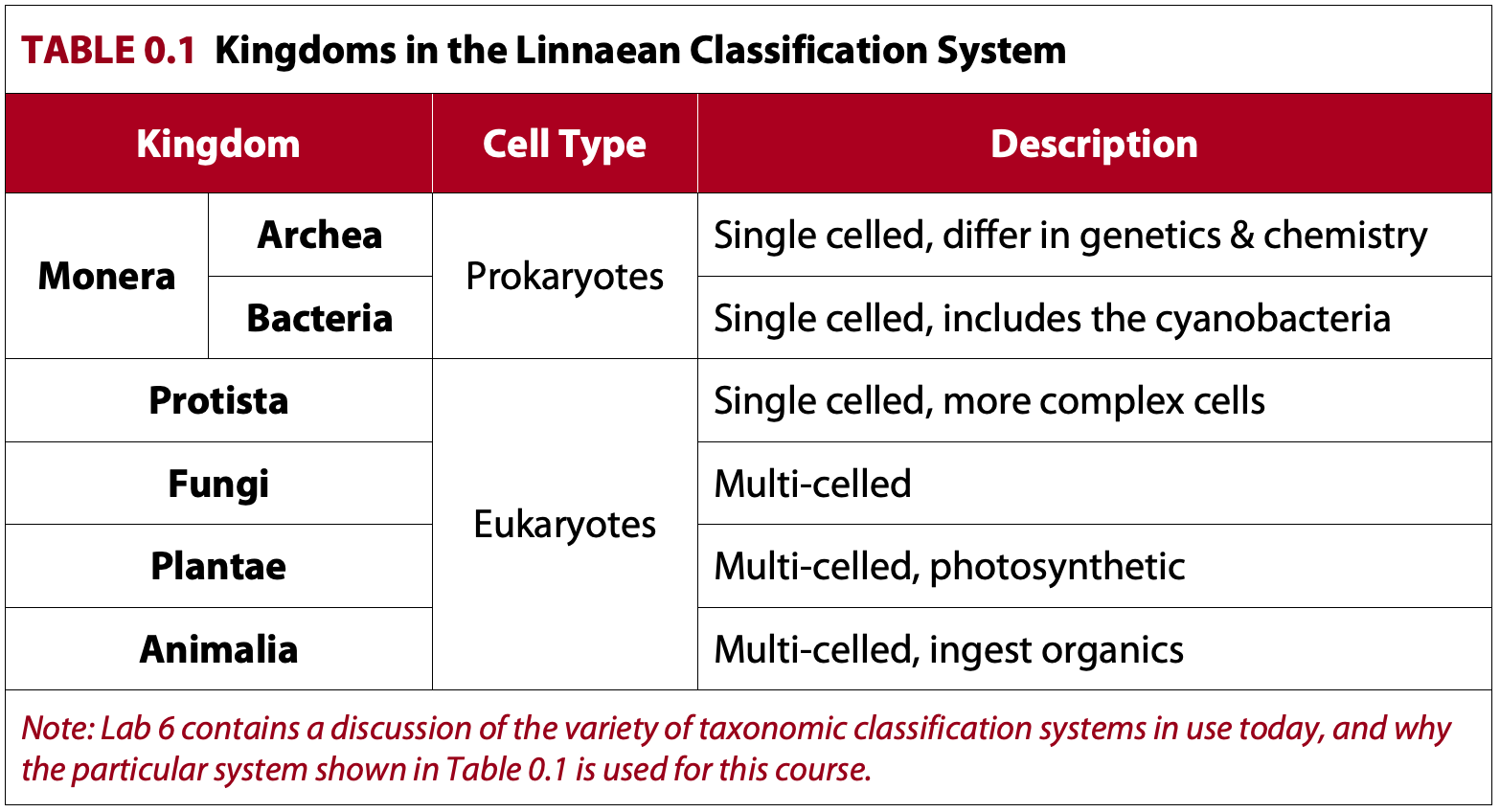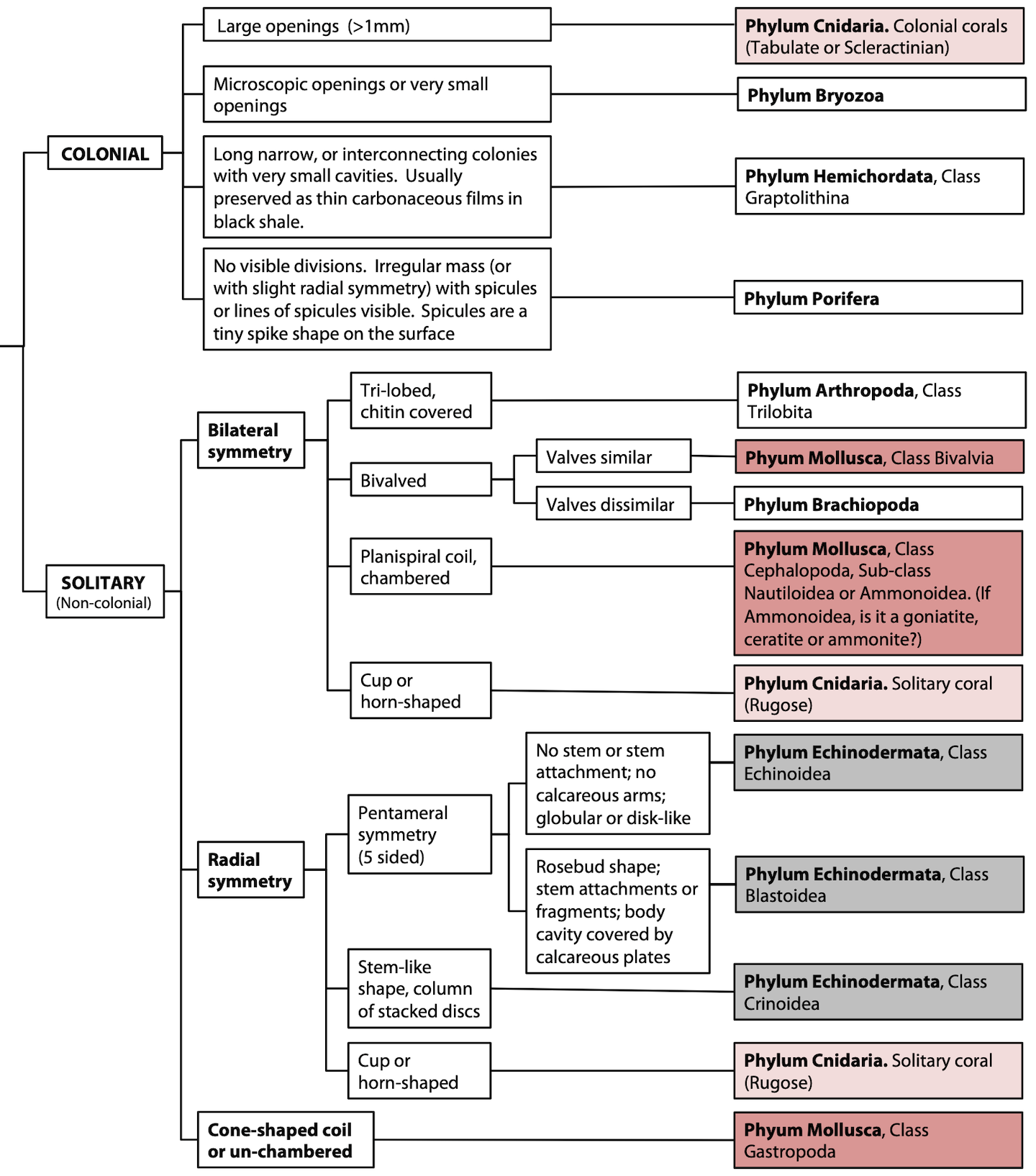Guide to Fossil Classification
Table 0.1 summarizes the kingdoms in the Linnaean classification system that we will follow for this course. Most of the groups we will be examining are part of Kingdom Animalia, but there are a few exceptions.

The laboratory exercises for this course will focus on the major marine invertebrate groups that evolved since the Precambrian, listed below.
You will be responsible for naming and describing the significance (geological or evolutionary) of each bolded group, and in some cases identifying them from fossilized remains (also underlined). Other groups are listed below for which you will examine fossils, but are not expected to remember classification, or are provided for context only.
This can seem like a daunting amount of information to remember at first look, but you will have several weeks to become familiar with these organisms and their fossils. Starting with Lab 6 you will start working with the Fossil Identification Flowchart (Figure 0.1) that will help you. You will be able to use this flowchart in the lab final.
Lab 6: Life in the Precambrian and the Cambrian Explosion
Kingdom Monera (Archea and Bacteria) – e.g. stromatolites
Kingdom Protista – single celled Eukaryotes
Kingdom Animalia
Phylum Annelidia – worms (and worm burrows)
Phylum Porifera – sponges & Phylum (?) Archeocyatha (may or may not be part of Porifera)
Phylum Cnidaria – the jellies and sea anemones
Phylum Arthropoda – invertebrate animals with jointed legs and segmented bodies
Class Insecta – insects
Class Crustacea – lobsters, crabs, barnacles
Class Trilobita – trilobites
Phylum Hemichordata
Class Graptolithina – graptolites
Lab 7: Fossils of the Paleozoic, and Paleoecology
Kingdom Animalia
Phylum Cnidaria – the corals
Tabulate
Rugose
Scleractinian
Phylum Bryozoa – bryozoans
Phylum Brachiopoda – brachiopods
Phylum Mollusca – molluscs
Class Bivalvia – bivalves (clams, oysters, scallops)
Class Gastropoda – snails, conchs
Lab 8: Fossils of the Paleozoic and Mesozoic
Kingdom Protista
Note: The Linnaean classifications for the microscopic organisms we will examine in Protista are too complex to be worth remembering. You will be expected to know the “working” names of these groups, along with what they are, what their shells were made of, and whether they were plants or animals.
Acritarchs
Dinoflagellates
Coccoliths
Diatoms
Radiolaria
Foraminifera
Kingdom Animalia
Phylum Echinodermata – echinoderms
Class Echinoidea – sea urchins, sand dollars, heart urchins
Class Crinoidea – crinoids (“sea lilies”)
Class Blastoidea – blastoids (“sea buds”)
Class Asteroidea – starfish,
Class Ophiuroidea – brittle stars
Phylum Mollusca – molluscs
Class Cephalopoda – squids, nautiloids, ammonites, belemnites
Note: The sub-classes of Cephalopoda will be discussed using their “working names” (e.g., goniatites) rather than the exact classification names (e.g., Goniatitina). The “oid” names for sub-classes (nautiloids, ammonoids) and the “ites” names for orders (ceratites, goniatites, ammonites) are the ones you are expected to remember.
Sub-Class Nautiloidea – nautiloids
Sub-Class Ammonoidea – ammonoids
Order Goniatitina – goniatites
Order Ceratitina – ceratites
Order Ammonotitina – ammonites
Fossil Identification Flowchart

